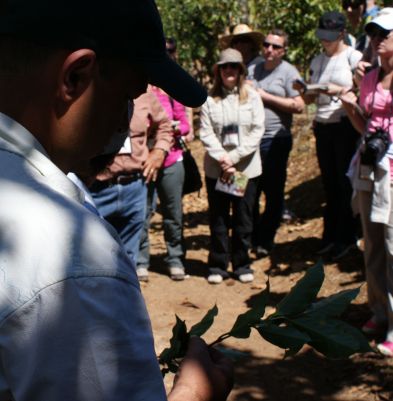Each night in Origin as we traveled back to the hotel on our buses, we engaged in reflection and discussion about our day.
Sometimes our sentiments were uplifting, and shared of the passion that we felt or the excitement and the energy that infused us. Other times our sentiments were heavy, full of deeper levels of contemplation, of appreciation for the lives lived that make coffee possible.
One of the words that struck me at the end of the third day, and that has continued to resonate in my consciousness, is Mercy.
You see, in coffee farming, numbers are everything. Where the peg falls on this board determines your livelihood. It is the difference between a good year, and a bad year. It dictates if you can put food on your table to feed your family, and buy the fertilizer you need to feed your crops, in an attempt to do it all again next year.

In coffee, you live at the mercy.
You are at the mercy of the coffee leaf rust fungus, that can plague your crops when it is dry.
You are at the mercy of the american leaf spot fungus, that can plague your crops when it is wet.
You are at the mercy of the nematoads, that can plague your crop from the ground.
You are at the mercy of the broca beetle, and its eggs that destroy your beans.
You are at the mercy of the market, and volatile swings in coffee prices.
You are at the mercy of the laborers, and their ability to pick only ripe cherries.
Youare at the mercy of the rain gods, and their providing the water that you need.
You are at the mercy of the co-op, and access to the wet mill for processing.
You are at the mercy of the city, and her constant calling to sell off your land for development.
You are at the mercy of the coffee board, and the soundness of the advice given out to your region.
You are at the mercy of the exporter, and the agreement he negotiates on your lot.
You are at the mercy of your children, and their commitment to be a part of it all.
You are at the mercy.
Do you ever think about it? How closely each one of us actually lives to this life, without even knowing it or appreciating it? The idea that any of us lives in a state of less mercy than our coffee farmers is simply an idea of illusion.
We are all connected in this sate of living at the mercy, much more deeply than any of us care to realize or remember. That paycheck you rely on from your employer? You are living at that businesses’ mercy. That hurricane that devastated your family’s home? You are living at nature’s mercy. That person you rely on for childcare? You are living at a young woman’s mercy. That market crash that devastated your retirement savings? You are living at the economy’s mercy.
The only difference between you and the farmers, is the courage that they have to live life at the mercy so purely, so overtly, so completely.
No frills. No safety net. No escape plan. You have every inch of your skin in the game.
It’s no wonder the Costa Rican’s live by the saying “Pura Vida.” Their farmers live the purest, most courageous life I can imagine.




